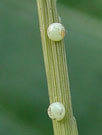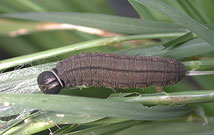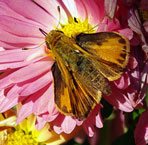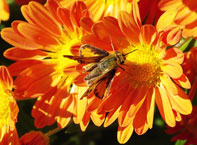home | fall garden | newcomer garden
Fiery Skipper
Fiery skipper gets its name because males are a brilliant, bright orange color. Females are a dull brown color. Fiery skippers are native to North America and are found in sunny, open areas such as fields, gardens, and roadsides. A distinct feature of the fiery skipper is a hooked knob at the end of each of their two antenna. Fiery skippers along with all other skippers can hold their wings in a "triangle" shape. The forewings are help upright and the hind wings are folded flat. This is thought to better absorb the sun's rays. Adult female skippers lay their eggs singly on the underside of grass leaves. Newly hatched larvae will eventually grow big enough to consume entire leaves. They are considered a pest of grasses such as Bermuda, St. Augustinegrass, and crabgrass. Damage appears as a 1- to 2-inch diameter round spot from with all the grass has been eaten by a single larva. If there is a large population, then these spots will become dead patches. Larvae are about 1 inch long and have an oversized black head, narrow neck and a greenish brown body color. Larvae spin silk shelters an inch or two under the soil surface so are hard to detect.
 |
 |
 |
 |
 |
